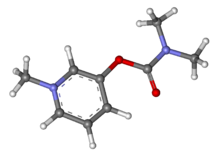 | |
 | |
| Clinical data | |
|---|---|
| Trade names | Mestinon, others |
| AHFS/Drugs.com | Monograph |
| MedlinePlus | a682229 |
| Pregnancy category |
|
| Routes of administration | By mouth, intravenous |
| Drug class | Acetylcholinesterase inhibitor; Parasympathomimetic |
| ATC code | |
| Legal status | |
| Legal status | |
| Pharmacokinetic data | |
| Bioavailability | 7.6 ± 2.4% |
| Elimination half-life | 1.78 ± 0.24 hours |
| Excretion | kidney |
| Identifiers | |
| |
| CAS Number | |
| PubChem CID | |
| DrugBank | |
| ChemSpider | |
| UNII | |
| KEGG | |
| ChEMBL | |
| CompTox Dashboard (EPA) | |
| Chemical and physical data | |
| Formula | C9H13N2O2 |
| Molar mass | 181.215 g·mol−1 |
| 3D model (JSmol) | |
| |
| |
| (verify) | |
Pyridostigmine is a medication used to treat myasthenia gravis[1] and underactive bladder.[2] It is also used together with atropine to end the effects of neuromuscular blocking medication of the non-depolarizing type.[3] It is also used off-label to treat some forms of Postural orthostatic tachycardia syndrome. It is typically given by mouth but can also be used by injection.[3] The effects generally begin within 45 minutes and last up to 4 hours.[3]
Common side effects include nausea, diarrhea, frequent urination, and abdominal pain.[3] More severe side effects include low blood pressure, weakness, and allergic reactions.[3] It is unclear if use in pregnancy is safe for the fetus.[3] Pyridostigmine is an acetylcholinesterase inhibitor in the cholinergic family of medications.[3] It works by blocking the action of acetylcholinesterase and therefore increases the levels of acetylcholine.[3]
Pyridostigmine was patented in 1945 and came into medical use in 1955.[4] It is on the World Health Organization's List of Essential Medicines.[5] Pyridostigmine is available as a generic medication.[3][6]
- ^ World Health Organization (2009). Stuart MC, Kouimtzi M, Hill SR (eds.). WHO Model Formulary 2008. World Health Organization. p. 429. hdl:10665/44053. ISBN 9789241547659.
- ^ Moro C, Phelps C, Veer V, Clark J, Glasziou P, Tikkinen KA, Scott AM (November 2021). "The effectiveness of parasympathomimetics for treating underactive bladder: A systematic review and meta-analysis". Neurourology and Urodynamics. 41 (1): 127–139. doi:10.1002/nau.24839. PMID 34816481. S2CID 244530010.
- ^ a b c d e f g h i "Neostigmine Bromide". The American Society of Health-System Pharmacists. Archived from the original on 21 December 2016. Retrieved 8 December 2016.
- ^ Fischer J, Ganellin CR (2006). Analogue-based Drug Discovery. John Wiley & Sons. p. 540. ISBN 9783527607495. Archived from the original on 2016-12-20.
- ^ World Health Organization (2019). World Health Organization model list of essential medicines: 21st list 2019. Geneva: World Health Organization. hdl:10665/325771. WHO/MVP/EMP/IAU/2019.06. License: CC BY-NC-SA 3.0 IGO.
- ^ "Competitive Generic Therapy Approvals". U.S. Food and Drug Administration (FDA). 3 March 2023. Retrieved 6 March 2023.